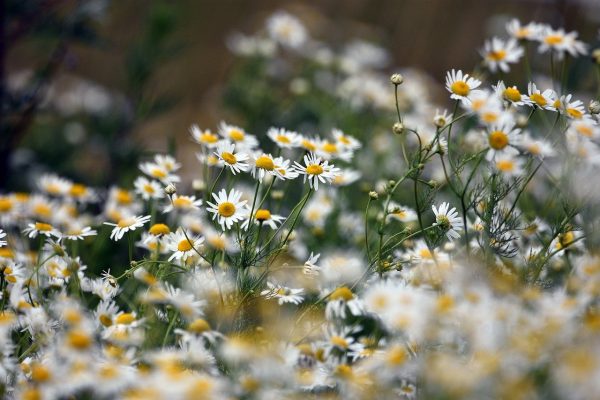
If you made it through the past year without feeling like you could use a cup of chamomile tea, you may be an outlier. Chamomile is known as an herb that may help us sleep, lift our moods and soothe our nervous digestive systems.
A cup of chamomile tea in the evening is a lovely thing, as is seeing its small, perky flowers in the garden. These flowers are a welcome sight to many beneficial insects, too, including pollinators.
How to Grow Chamomile
Whether growing German or Roman chamomile, garden prep and preferences are the same. The plant is an annual in Kentucky that frequently reseeds itself, so I plant it in my perennial bed and let it do its thing.
You might also put yours in a container or an ornamental bed nearer to your house. Chamomile is delicate looking and blooms all summer long. So it’s a nice plant to come home to.
To start, seed chamomile indoors a month and a half or two months before your last frost. It’s a tricky one to germinate—which makes little sense given its reseeding tendencies—so seed more than you think you need the first year.
The seeds are tiny and need light to germinate. You’ll press them into the soil rather than covering them.
Transplant chamomile seedlings after the threat of frost has passed. Try to time this so the plants aren’t too big, as transplant shock is common with this shallow-rooted plant.
Spacing chamomile plants in the garden is easy the first year. It’s harder in subsequent years, when it’s reseeding itself. Aim for 1-foot spacing between plants if you’re going for a packed look. Use 2-foot spacing if you want to give each plant room to bloom to its full potential.
Because chamomile has shallow roots, it doesn’t compete well with weeds. Consider mulching, even with something as simple as grass clippings, to reduce weed pressure. Use caution when weeding around plants, whether that’s by hand or using a cultivating hoe, as it’s easy to disturb their roots.
Ensure chamomile has adequate water—again, the roots are shallow—but don’t drown it. While the soil doesn’t need to be top notch, it should be well draining.
Read more: What are the differences between German and Roman varieties?
How to Harvest
The daisy-looking blooms are the part of the plant that you want to harvest. The stems have a more bitter flavor. Cut or pluck the flowers early in the day, when they’re just about open.
A regular harvest will keep the plant producing until frost. Don’t worry about the flowers you miss. Pollinators and other insects will appreciate them, and those flowers will allow the chamomile to reseed.
Read more: Grow and use these herbs to alleviate stress and anxiety.
How to Use Chamomile
Most of these Produce Profiles cover how to eat whatever plant we’re talking about. Chamomile is less about eating, more about drinking.
Tea is chamomile’s primary use—or tisane, to be correct, as a tisane is an herbal infusion that doesn’t involve actual tea (Camellia sinensis) leaves. Chamomile tea can be consumed hot or cold. Either way, steep the blooms for no longer than five minutes, as they taste bitter if steeped for too long.
Blended with other herbs, chamomile adds a nice floral note to whatever you’re drinking. A favorite nighttime tea of mine is lavender, catnip and chamomile. Check in with a trusted herbalist for ratios and recipes.
Be fancy and make a tea latte or—I won’t stop you—the ultimate relaxation hot toddy.
As with most herbs, chamomile is a good one for simple syrup, which you can use to make homemade soda, to drizzle on plain yogurt and to add to cocktails.
Beside beverages, the fresh flowers are edible and make dainty decorations for your baked goods. (I don’t have this kind of patience, but I love seeing others’ beautiful, botanically decorated creations.)
The benefits of this bright spot in your garden are plenty: an opportunity for good rest for you, an attractant for good bugs for your other plants and a beautiful bunch of blooms for the whole season.
Raise a glass of chamomile tea for easy, beautiful garden herbs.




